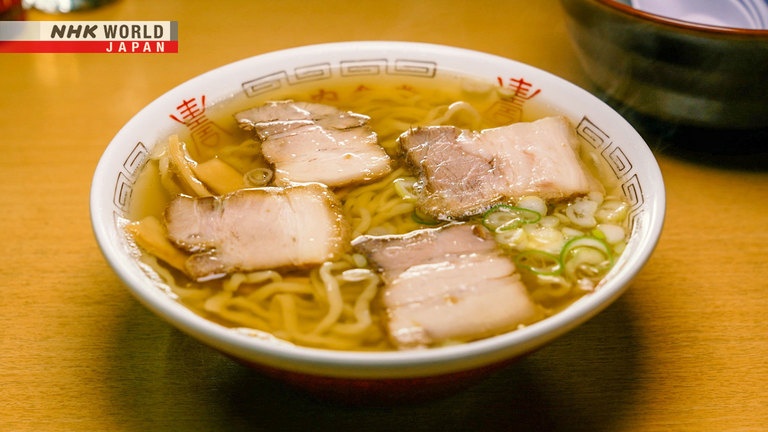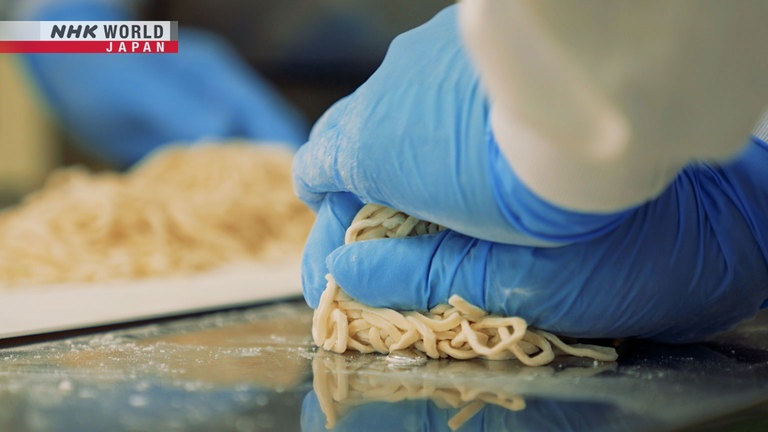FUKUSHIMA
A line-up for ramen in the morning?! Head to an area attracting visitors from around the country in search of ... ramen!




Transcript
Ramen Japan!
This time we head to Fukushima.
Here we come across two trend-setting ramen variations that took the nation by storm.
Kitakata and Shirakawa ramen.
Welcome to Japan, the land of ramen!
Alongside Hakata and its tonkotsu...
...and Sapporo, with its miso ramen,
another town synonymous with ramen is found right here in Fukushima.
Just 50km southwest of the prefectural capital, the city of Kitakata.
A quiet town, home to around 40,000 residents.
it's Sunday morning, and there's already a long line at this local ramen shop.
Sorry for the wait. Please come in.
As soon as they open at 7, customers from all over the country are eager for a taste.
Delicious.
It's actually better in the morning.
It's now Monday, and just like the day before, the customers line up early.
The same on Tuesday.
Ramen in the morning, Kitakata style.
I used to come in on the way to school
instead of having breakfast at home.
I just got off the night shift.
That always makes me want to eat it.
I always have ramen in the morning.
I come in about twice a week.
There are now around 90 ramen shops in Kitakata.
The shop owners joined together to create the Kitakata Ramen Association.
At this member shop, we find out what makes their ramen so special.
The soup stock is made with pork and chicken bones, pork back fat, dried anchovies and vegetables.
Even if salt or soy sauce is added,
it's never salty; a mild, flavorful soup.
Most distinctive are the curly, thick noodles.
Springy texture and curl hold the soup
for the best eating experience.
Most shops in Kitakata order their noodles
from specialist manufacturers.
Founded in 1966, this noodle maker supplies over half the ramen shops in the city.
Just being curly isn't enough,
they have to be the right kind of curly.
But, in addition to the curling done by the machines, this factory takes it a step further.
They're finished by hand.
Each ball of noodles is kneaded to add curl, creating irregularities impossible with a machine.
Tanaka Kiyoko is one of the workers.
It's hard to do right.
If you use too much force,
you end up crushing the noodles.
The strength required also changes with the weather.
Every one has to be delicious.
This is Kitakata's first ever ramen shop.
Welcome!
Here's your order.
This is where the noodles got their curl.
The one who started it all, Ban Kinsei.
In 1925, he left China on his own in search of employment.
Just 19, he started selling the noodle dishes of his home country in order to survive in his adopted home.
So they combined well with the soup, he made curly noodles by hand.
This one bowl of noodles spread all over Kitakata.
And there were soon over 100 shops in the area.
Simply delicious.
People come from all over Japan to sample Kitakata ramen.
The reason is one man.
It's all thanks to Tomiyama Shoji.
He's the one who really promoted it.
Tomiyama worked in the tourism office at Kitakata City Hall.
In 1983, he was looking for a way to bring in more visitors to the area.
Tomiyama's eye was caught by the local ramen.
With approval from City Hall and the Mayor, he purchased a full page in a travel magazine.
He wrote a feature article himself, the first to link Kitakata with ramen in the public mind.
He was probably one of the first
to give ramen a regional identity
linked to such a small city.
Widespread name recognition
for Kitakata was the result.
Annual visitors had been around 50,000,
but after the article they jumped to over 4 times that.
Tomiyama united former rival shops, forming the Kitakata Ramen Association in 1987.
And as a guide to local ramen shops, he also produced this hand-drawn map.
Available for free at stations and shops, the 60,000 copies of the first edition quickly ran out.
To this day, 36 years later, it's kept up-to-date.
This family is here from Gunma.
We first came here five years ago.
Kitakata ramen was unforgettable.
This man is from Ibaraki.
When I hear "Kitakata,"
ramen is all I can think of.
In 2022, visitor numbers topped 1.2 million!
70 km south of Fukushima City lies the city of Shirakawa; population, around 60,000.
But this small town is home to over 100 ramen shops.
At this long-standing shop founded in 1969, let's find out what makes ramen here so good.
This customer came from Ibaraki.
I come in regularly, once every month.
This family came from Saitama.
Great!
You just slurp it down like that.
It's something you drink.
- It's so yummy!
- It sure is!
This local has been coming since the shop was founded.
I think it's the best ramen in Japan.
Kazuyuki is the one who made
Shirakawa ramen so great.
Takei Kazuyuki. The second-generation owner, he took over in 1982.
Dad was originally a farmer.
He wondered if soba making methods
couldn't be used for making ramen.
That's how handmade
Shirakawa ramen started.
The soup stock is made with pork bones and select chicken parts.
It's clear, with the lightness of "shoyu"
but also a richness.
Most distinctive, are the homemade noodles.
Noodle making begins at 4 am.
Shirakawa ramen is made from scratch every day.
To give them resilience, they're kneaded under foot for 10 minutes.
The dough is then further stretched with a bamboo rolling pin.
Keeping it from getting too dry requires both care and agility.
All that effort results in just 60 portions!
Repeating this 3 times, the noodles are then left to rest for three days and they're finally ready.
The mouthfeel is totally different
with handmade noodles.
It's the ultimate goal that
I've spent 40 years pursuing.
Shirakawa ramen was the creation of his father, Toraji.
He took on apprentices who then
took on their own apprentices,
and ramen shops spread all over town.
His son Kazuyuki also had many apprentices of his own,
ensuring the legacy of his father's handmade noodles.
Having trained under Kazuyuki, 30 years ago Watanabe Noboru opened his own shop.
His teachings have spread to nearly
every ramen shop in Shirakawa.
He teaches everything,
but nobody can learn it all.
That's why everyone in Shirakawa
is so committed to doing things his way.
Shirakawa ramen's national fame all started because of an event held by the city.
Shirakawa has nothing like traditional inns,
so we used ramen as the starting point.
The city turned to Takei Kazuyuki, with his many apprentice ramen makers, for help.
We didn't put everything on him,
but it would've been hard without his help.
In 2004, Shirakawa held its first ramen festival.
It featured not only local ramen shops, but famous ramen makers
from all over the country following in Kazuyuki's footsteps.
A Fukuoka tonkotsu brand with branches worldwide...
A long-standing Sapporo miso ramen maker also participated.
And the ramen for the special event was made by the owner himself.
The two-day event attracted 60,000 visitors from across the country.
The venue was completely packed.
I remember feeling just
how much power ramen really has.
The level of enthusiasm was incredible.
Ramen shops can really do something.
I feel like we have the power
to make a difference in the world.
I suddenly felt like having some,
this morning, so I came in.
April 2023.
The tourist information center set up a new ramen database.
You can specify the type of soup, and of course the style of noodles, to find the shop that suits you.
Currently only available in Japanese, it will eventually become multilingual
as part of an effort to welcome overseas guests.
Kitakata, and Shirakawa, two small Fukushima cities.
But both have become destinations for visitors from all over the country
in search of the ramen that bears their names.
The incredible taste of the local ramen is passed down by people with true passion,
from the very first bowl, to the present day.
Wouldn't you like some yourself?
Come pay a visit for the best bowl of ramen you've ever had!